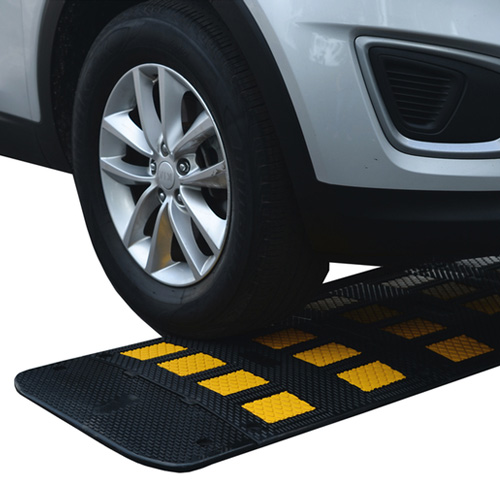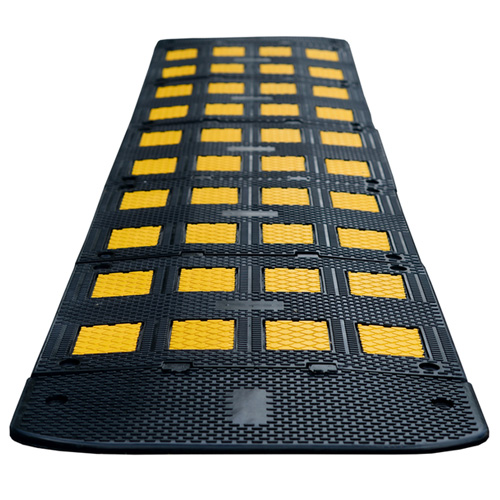Rubber speed bumps for concrete are a highly effective solution for traffic calming in various environments, offering numerous benefits and practical features. Here’s a comprehensive overview:
Features of Rubber Speed Bumps for Concrete
- Durability: Made from high-quality, recycled rubber, these speed bumps are built to withstand heavy traffic, extreme weather conditions, and daily wear and tear.
- Modularity: Often available in modular sections, allowing for easy customization in length and width to fit specific needs.
- Visibility: Equipped with reflective tape or embedded reflectors to enhance visibility, especially at night or in low-light conditions.
- Noise Reduction: Quieter than metal or plastic alternatives, making them ideal for residential areas where noise reduction is important.
- Portability: Lightweight and easy to install, remove, or relocate as needed.

Advantages of Rubber Speed Bumps for Concrete
- Easy Installation: Rubber speed bumps can be installed quickly and easily on concrete surfaces with minimal tools and equipment. They usually come with pre-drilled holes and installation hardware.
- Eco-Friendly: Many rubber speed bumps are made from recycled materials, contributing to environmental sustainability efforts.
- Cost-Effective: Generally more affordable than traditional materials like asphalt or concrete, both in terms of initial purchase and maintenance costs.
- Versatility: Suitable for a wide range of locations, including residential streets, parking lots, school zones, and private roads.
- Safety: Effectively reduces vehicle speeds, improving safety for pedestrians and other road users.
Considerations When Choosing Rubber Speed Bumps for Concrete
- Quality: Ensure the rubber speed bumps are manufactured from high-quality materials to ensure longevity and performance.
- Dimensions: Select the appropriate height, length, and width to achieve the desired speed reduction while accommodating the types of vehicles that will traverse them.
- Reflective Features: Opt for speed bumps with adequate reflective markings or embedded reflectors for improved visibility.
- Compliance: Verify that the speed bumps meet local regulations and standards for traffic calming devices.
- Warranty and Support: Choose suppliers offering warranties and reliable customer support to handle any post-installation issues.

Installation Process
- Site Preparation: Clean the concrete surface where the speed bump will be installed, ensuring it is free from debris, oil, and dust.
- Positioning: Place the speed bump sections in the desired location and mark the positions of the pre-drilled holes on the concrete.
- Drilling: Use a hammer drill to create holes in the concrete for the anchor bolts.
- Anchoring: Insert the provided anchor bolts through the speed bump and into the drilled holes, securing them tightly.
- Final Check: Ensure the speed bump is securely fastened and test for stability.
Leading Suppliers
- Traffic Safety Store: Offers a variety of rubber speed bumps with different sizes and reflective options.
- Discount Rubber Direct: Provides recycled rubber speed bumps suitable for different traffic scenarios.
- Barco Products: Known for modular speed bump systems, allowing for customized length and configuration.
- Seton: Supplies durable rubber speed bumps with high visibility features for enhanced safety.
Applications
- Residential Areas: Helps reduce speeding in neighborhoods, making streets safer for pedestrians and children.
- School Zones: Ensures vehicles slow down near schools, protecting students during peak hours.
- Parking Lots: Controls vehicle speed, reducing the risk of accidents and improving pedestrian safety.
- Private Roads: Used in gated communities and private estates to manage traffic speed effectively.
Benefits of Using Rubber Speed Bumps on Concrete
- Enhanced Safety: Slows down vehicles, reducing the risk of accidents and improving pedestrian safety.
- Low Maintenance: Requires minimal maintenance compared to traditional asphalt or concrete speed bumps.
- Flexibility: Can be easily removed or relocated if traffic patterns change.
- Environmental Impact: Utilizing recycled materials helps reduce environmental footprint.
In summary, rubber speed bumps for concrete surfaces are a versatile, durable, and eco-friendly option for traffic calming. They offer easy installation, cost-effectiveness, and enhanced safety, making them an ideal choice for various applications in both residential and commercial settings.
